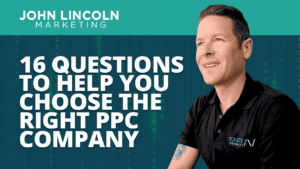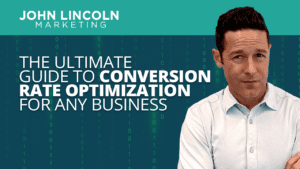
Top 16 Questions to Ask a PPC Company in 2024
In 2024, choosing the right PPC company is not just about spending your advertising budget. You want to make every cent count towards your business
In this guide, I’ll offer seven tips to help you get the ball rolling if you’re a newbie. And if you’ve got some experience, I’m sure you’ll find a few nuggets of info that you can use to take your online advertising to the next level.
Ready to go? Let’s get started.
There’s no shortage of ad networks that you can choose from. And that list isn’t shrinking.
You can run social media ads, search ads, native ads, display ads, or just flat-out purchase some digital space on a website.
So where do you go?
The answer is: it depends.
It depends on a few things, actually:
If you’re in the B2B space, take a good look at advertising on LinkedIn. That’s probably where you’re going to drum up the most business.
On the other hand, if you’re in the ecommerce space and selling consumer goods, consider going with search ads optimized for keywords relevant to the stuff you’re selling.
For example, if you’re selling raccoon traps, run an ad optimized for “inexpensive raccoon traps” or “humane raccoon traps.”
You can also get your product detail page to appear at the top of the search results if you’re playing with Google Shopping. You might find that’s all you need to do if you’re in a niche space.
And then there are social media options other than LinkedIn. Hangouts like Instagram, TikTok, and Facebook offer great opportunities to build brand-name awareness.
Just make sure you run ads relevant to the kind of content that people are looking for on those platforms. That’s especially true when it comes to TikTok and Snapchat.
As the folks at TikTok like to say: don’t create ads, create TikToks. You’ll likely land more business if you follow that advice.
Native ads are attractive if you’re running a website that offers viral content and you earn money by people clicking on ads on your site.
By the way, if you’re unfamiliar with native ads, they’re ads that look like “normal” content on a website.
In other words, they’re ads in disguise.
But you can get a lot of traffic with the right placement of native ads.
Display ads work well if you want to play show and tell with a product that you’re selling. Or if you’ve got a catchy image that’s sure to grab people’s attention and tempt them to click on the ad.
When it comes to a budget, the good news is that most of the ad networks offer a pay-per-click (PPC) option. That means you only pay when somebody clicks on your ad.
And if you’ve done a good job selling your product on the landing page, you should get a nice return from the price of that click.
Ad networks will also let you set a maximum budget. Once you hit that maximum, your ad will stop running and you won’t have to worry about cost overruns.
But there’s more you need to consider when selecting the right place to run your ads.
Make sure you pay attention to brand safety.
Simply put: there are some websites you don’t want your ads to appear on. Otherwise, you could do damage to the reputation of your business.
If you are seen in any way as sponsoring hateful or violent content, you could lose a lot of money.
But beyond the financial hit, you probably don’t want to run ads on those sites as a general principle.
So make sure you select an ad network that lets you blacklist certain places in cyberspace. That way, you’ll stay out of trouble.
Also, talk to an attorney before you start your advertising splurge.
Why? Because you want to make sure you’ve got all your legal ducks in a row when it comes to making promises about your product or service.
Otherwise, you could end up on the business end of a lawsuit. Best-case scenarios involve spending a fortune in legal fees to defend your business or settling out of court.
In either case, you’re losing money you wouldn’t have to lose if you got your attorney involved in the first place.
Also, make sure your landing page is compliant with prevailing regulations right here in the U.S. and anywhere else around the world where you’re running ads.
Fail to do that and you might face some steep fines.
Next up: make sure you’ve laid the foundation by configuring your digital marketing tools.
This is an important step because once you start the marketing journey, you want to know how well you’re doing.
Let’s say you’re running ads on both Facebook and Google Search. And you’re reeling in lots of customers.
Okay. Are the majority of those customers coming from Search or Facebook?
Without tracking tools, you won’t know the answer to that question.
It could be that you’re getting the lion’s share of customers from Search. If that’s the case, you might want to scale back on Facebook advertising and invest more heavily in Search ads.
But again: you won’t be able to make that decision without tools that tell you how well you’re doing with each channel.
Fortunately, most of the ad networks offer their own analytics tools. So you can at least tell how many clicks you’re getting.
But when it comes to conversions (when people who click actually become customers), you’ll need to do a little more analysis.
Sometimes folks become customers after one click. But there are folks who need to visit your site a few times before they actually pull the trigger.
That’s why you’ll need to get your attribution model established up front.
If you’re unfamiliar with the concept of an attribution model, it’s the digital strategy that answers the question: “Which ad gets the credit for giving me this sale?”
It might be that you want to go with a last-click attribution model. That’s when the last ad the person clicked on before converting gets the credit.
Or you could go with a first-click model. Or a weighted model.
The point here is: make sure you get that established as part of your digital marketing foundation before you run ads.
By the way, a great tool to use when it comes to evaluating various attribution models is also available free of charge: Google Analytics 4 (GA4).
Definitely familiarize yourself with GA4 before you start running ads. Get it configured correctly. Watch YouTube tutorials on how to get the most out of it. Read articles about its latest features.
Finally, invest in a dashboard tool that shows you at a glance how well your marketing efforts are paying off.
It’s not likely you’ll find something that suits your business right out of the box. So expect to do some development and configuration work when it comes to setting up your dashboard.
By “try the new stuff” I mean take a look at some of the more recent innovations in digital ads.
For example, Google’s value-based bidding is a fairly new bid strategy that can help you maximize your ad spend.
It works like this: you provide the characteristics of customers that are the most valuable to your business. Then Google will go out of its way to show your ad to people who share those characteristics.
Bottom line: your ad appears in front of people who will more likely convert instead of just kicking a few tires.
There’s another ad option you should look at: enhanced conversions. That’s when you share conversion data (such as the customer’s email address, phone number, etc.) with Google.
I know. That sounds like a privacy violation. But there’s a reason why you would want to do that.
It’s so that Google can more accurately measure your conversions. Hence the term “enhanced conversion measurement.”
Then there are Performance Max campaigns. They let you access your entire Google Ads inventory from a single campaign.
Why would you want to do that? To maximize your reach.
You can launch a single campaign that runs ads on Search, websites, YouTube, Gmail, Maps, and Discover.
It’s a great way to find people in your target market that you haven’t yet reached.
Next, you’ll want to put on your prophet’s hat and start forecasting.
Specifically, you’ll want to forecast how well your ads (and, by extension, your sales) will perform over:
Why is that important? So that you can determine how to budget your marketing bucks in the foreseeable future.
For example, let’s say the trend is your friend and sales have grown over the past quarter. You also know that you’re not on the downward slope of the product life cycle.
In that case, you forecast an increase in sales of 12% during the next quarter.
Armed with that info, you know enough about your cash flow to determine if it’s a good idea to invest more money in successful marketing channels.
And when you decide to make that kind of an investment, you might end up with a very pleasant surprise: you lowballed your sales growth for the coming quarter.
That’s when it’s good to be wrong.
You might think you’ve got a really great marketing campaign with some awesome copy. But maybe one of your partners has an idea for even better copy.
What do you do then?
You run split tests.
If you’re not familiar with split tests, they’re “trial runs” of different ad options. In the example above, you’d run one test with your copy and another test with your partner’s copy.
And when those tests have run their course, check your analytics to see which copy “won.” If there’s a clear winner that got you way more conversions than the other one, you’ll want to use that copy for the remainder of your campaign.
Keep in mind: you’ll need to use a sample size large enough to establish a trend. Otherwise, you’re just playing a guessing game.
To get the correct sample size, enlist the aid of some online statistical resources. Your ad network might be able to offer some assistance in that area.
If not, Optimizely has a tool that you might find useful.
And by the way, don’t just test your creatives, headlines, and copy. You should also test audiences.
Yeah. If you think you’ve uncovered a new segment with a lot of potential, test it out.
Benefits of a solid testing plan include:
If you’re collecting names, email addresses, and phone numbers, make sure you’re managing that data.
Simply put, all of that info is a gold mine of people who are interested in buying what you’re selling. Don’t ignore it.
Use that data to create the following lists:
And more.
Use those lists to create audiences that will respond to specific marketing messages.
There you have it. Seven great tips for paid media marketing in 2023.
You might not be able to take on all the action items I’ve recommended here at once. But you can pluck a few pieces of advice from the tips above and start working on those.
Then, later on, you can add on some additional strategies.
Happy marketing!
Welcome to John Lincoln’s personal website. On this website, we offer courses by John Lincoln, review software, publish articles and videos. You can also learn about John Lincoln’s books, films, book him to speak and contact him. John is directly associated with many of the businesses mentioned on this website and freely discloses this information.

John Lincoln is CEO of Ignite Visibility, one of the top digital marketing agencies in the nation. Ignite Visibility is a 4x Inc. 5,000 company. Ignite Visibility offers a unique digital marketing program tied directly to ROI with a focus on using SEO, social media, paid media, CRO, email, Amazon and PR to achieve results. Outside of Ignite Visibility, Lincoln is a frequent speaker and author of the books “Digital Influencer” and “The Forecaster Method.” Lincoln is consistently named one of the top digital marketers in the industry and was the recipient of the coveted Search Engine Land “Search Marketer of The Year” award. Lincoln has taught digital marketing and Web Analytics at the University of California San Diego since 2010, has been named as one of San Diego’s most admired CEO’s and a top business leader under 40. Lincoln has also made “SEO: The Movie” and “Social Media Marketing: The Movie.” His business mission is to help others through digital marketing.
Want to get in touch with John Lincoln? Click Here To Reach Out.

In 2024, choosing the right PPC company is not just about spending your advertising budget. You want to make every cent count towards your business

Whether you’re a seasoned marketer or just starting out, conversion rate optimization (CRO) is a powerful tool that can boost your sales, leads, and overall

Feeling overwhelmed by the sea of SEO companies out there? You’re not alone! Choosing the right partner is crucial for achieving your online marketing
 Keyword Strategy to Rank #1 in Google for Competitive Keywords
Keyword Strategy to Rank #1 in Google for Competitive Keywords If you're asking yourself, "How do I identify competitive keywords?" you've come to the right place. To fully dive into this